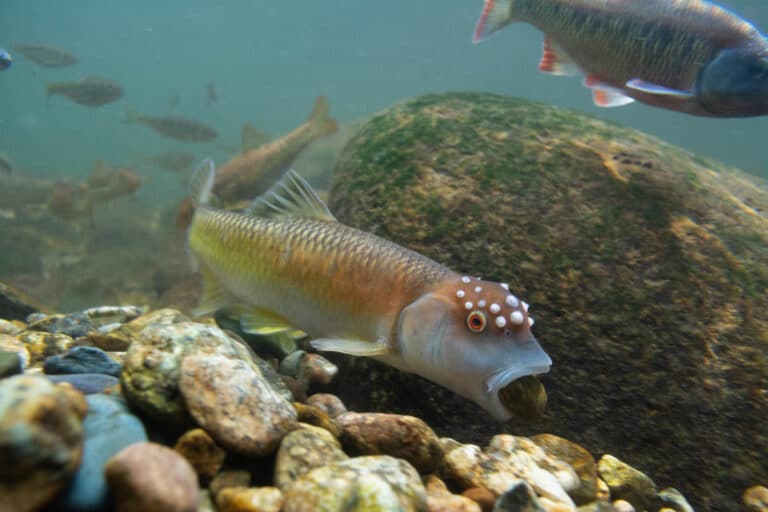“The forest belongs to all of us.”
“A lot of people don’t know that Black people live in the mountains,” says Lavita Logan. “We’ve been here a lot longer than most.”
Around 200 Black people live in Old Fort, N.C., a small community of 900 surrounded on three sides by Pisgah National Forest. Logan, an African-American woman who was born and raised in Old Fort, knows the forest well. She has explored the trails of Pisgah National Forest since she could walk, and she and her family swam in Curtis Creek every weekend.
These days, few Black people in her community are out in the woods. Logan wants to change that. She has helped launch Trails for All, a $2 million project that will soon bring 42 miles of new trail to the area around Old Fort. As project consultant, Logan hopes it will especially help the African-American community reconnect to the forests and creeks that surround the town.
Logan is partnering with the U.S. Forest Service, Camp Grier, and the G5 Trail Collective (named for the five counties of Pisgah’s Grandfather Ranger District). Over the next 10 years, they will construct trails to improve community connectivity and reduce barriers to access. Connector trails, loop trails, and two new trailheads close to town will make the outdoors easier to reach and explore.
Logan has also led a downtown mural dedication honoring her town’s Black history and is planning to run for office this fall: she hopes to become the first Black female alderman of Old Fort. BRO talked with Logan about her childhood in a rural mountain town, what has changed, and how trails can make her community stronger.
BRO: What was your childhood like as a Black girl in rural Appalachia?
I had a great childhood here in Old Fort. We had a lot of fun running around in these woods, swimming in the branches. I just loved being outside.
I was the only Black kid in Girl Scouts, but they didn’t treat me any different that I could tell. I loved camping. I loved swimming in Widow’s Hole in Curtis Creek. And there were a lot of Black people who loved the woods just like I did.
BRO: How did you launch the trails project?
I wanted to do something for my community. Our town is surrounded on three sides by Pisgah National Forest. Yet a lot of folks don’t know what’s right in their backyard. But the trails can be hard to reach.
I first joined the Old Fort Community Forum, which is mostly white folks. We created the People on the Move because of the lack of the Black community showing up to the forum. We’ve started a walking group that meets every Wednesday. We reached out to a local community college and a camp to provide more opportunities. Things just kept rolling from there.
BRO: How do we encourage more Black folks to get outdoors?
There’s a lot of stigma behind Black people in the woods, given the history of what happened to us in the woods, so I’m working hard especially to get kids out in the woods.
They need to see more people of color out there, people that look like them. It’s on all of us to set an example and blaze a path.
We gotta get as many young people out onto the trails as we can. They won’t all like it, but a few might be interested. They might make a living out of it or introduce it to their children someday.
Try something new. You never know if you might like it.
BRO: Why is this important to you?
It’s fun! Being in the woods is so much fun. I want young kids to have the same fun that I had.
The national forest that surrounds this town belongs to all of us. It’s for everyone to enjoy and benefit from.
Old Fort died for a while. The outdoors could help bring it back. I want our community to be healthy and vibrant, especially for Black people. I want Black entrepreneurs to launch businesses around the outdoor economy that takes root here. I want our whole community to benefit from the outdoors, both from a health perspective and an economic point of view.
It’s time for the Black community to get out and be more involved in the outdoors—and in community decisions. I want them to have a bigger piece of the outdoor pie.
BRO: How can white people help?
Trust is a big thing to the Black community. We don’t always trust a lot of people. The most important thing white folks can do to build trust is to show up. If you really say you’re gonna do something, show up and do it. Show that you are really serious and willing to do some work. That’s how we know you’re not just doing a lot of talking. Do what you say you are going to do.
Spend Some Time (and Money) in Old Fort
Old Fort adventures should already be on your bucket list. Here are three reasons why.
1. Kitsuma Trailhead: Mountain bikers already know that Kitsuma is one of the best descents in the Blue Ridge, and it all begins in Old Fort. The ten-mile loop begins with a steep climb from Royal Gorge Road near Old Fort.
2. Curtis Creek: This is one of the wildest sections of Pisgah National Forest and the headwaters of the Catawba River. The trail to Hickory Branch Falls is a short and sweet 1.6 miles. For a more rugged adventure, Mackey Mountain is a beautiful bushwhack. Throw down at Curtis Creek Campground at the end of the day.
3. Catawba Falls: One of the largest waterfalls in the region is just outside city limits and easily accessible via a short hike from the parking area.
Cover photo: Trails for All founder Lavita Logan. Photo courtesy of Logan







